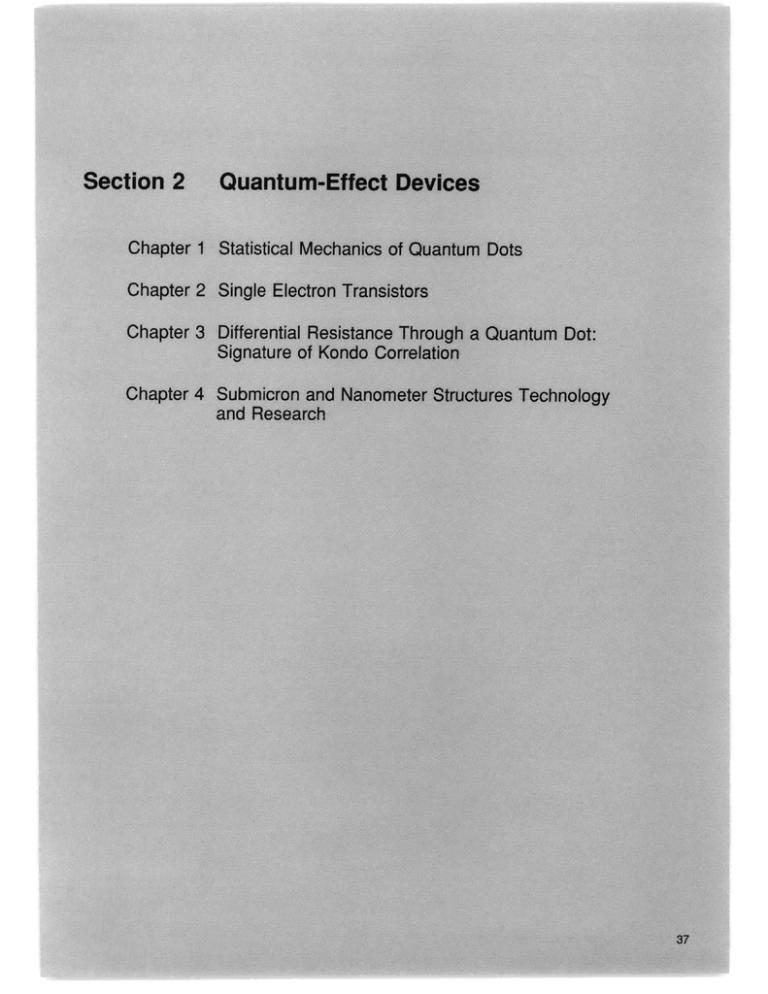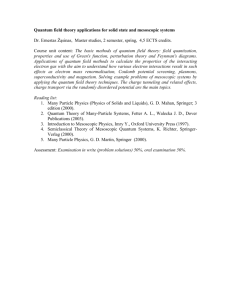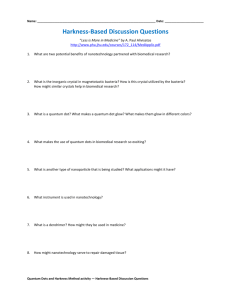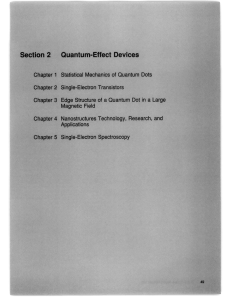Section 2 Oovllcos
advertisement

Section 2 Quantumew-Effect Oovllcos Chapter 1, Statistical Mechanit-8 of-',Odahturb Dots Chapter 2 Single Electroa TiahS'Wors Chapter 3, Differential ResistanIce, Tbrou'gh';a., Quantum Dot-, Signature of Kond'o.*Corre'lation',';'.',''.' Chapter. 4 Submicron'and- Nahlo iate $,tfU M ro's- Tech blogy and Researd h 38 RLE Progress Report Number 135 Chapter 1. Statistical Mechanics of Quantum Dots Chapter 1. Statistical Mechanics of Quantum Dots Academic and Research Staff Professor Boris L. Altshuler, Dr. Richard Berkovits, Dr. Aaron Szafer Graduate Students Michael Faas Technical and Support Staff Imadiel Ariel, Kristine M. Bowring 1.1 Project Description Sponsor Joint Service Electronics Program Contract DAAL03-92-C-0001 We are continuing to study equilibrium properties of quantum dots-isolated metallic systems with sizes an electron smaller than a typical length of dephasing. In contrast with the transport properties of these systems, their thermodynamics was relatively neglected by both theorists and experimentalists. We are investigating theoretically the dielectric properties of quantum dots. We have considered a neutral grain with a positive uniform background and conduction electrons which are scattered by disordered impurity centers. Due to the fact that the grain is disordered, one should expect a nonuniform distribution of charge inside the grain. The electric field outside a grain is determined by the charge distribution inside the sample. Therefore, in principle, it is possible to measure electric field outside the grain, although the grains net charge is equal to zero. This means that a neutral quantum dot without any external electric field possesses a finite dipole moment as well as higher-order multipole moments. We have calculated the mean square electric potential far from the grain surface and determined its temperature and magnetic field dependence.1 We have also considered the response of quantum dot to an external electric field and determined mesoscopic (sample to sample) fluctuations of the electric polarizability.2 The zero field (spontaneous) dipole moment, as well as the polarizability, depends significantly on the temperature and the magnetic field manifesting the quantum nature of the phenomena. Due to screening of the charge fluctuations in the bulk of the grain, both effects are rather weak, so that only the surface charge fluctuations are important. Nevertheless, for systems with relatively low-electron density (such as semiconductors), both effects are well within current experimental capabilities. Modern experimental technique allows us to resolve single-electron energy levels in a quantum dot.3 In most cases the electrons within a dot are scattered irregularly by impurities and the surface. Even for a "clean" quantum dot with a size much smaller than the mean free path, the motion of electrons can be chaotic rather than integrable due to the particular shape of the grain. The electron energy spectrum of these chaotic systems turns out to be rather irregular. We have started to develop a statistical approach to the description of chaotic energy spectra in the presence of external fields. First, we have considered a disordered mesoscopic ring with AharonovBohm flux D. The energy of a given electron state E, (we will measure ,, in units of mean energy level spacing A) is a periodic function of (, with a period o = hc/e. At the same time, on the interval 0 < ( < (o, this function E,(O) can be considered as a random one. We have found that the autocorrelation function of the derivatives dE,/d( (i.e., of 1 R. Berkovitz and B.L. Altshuler, "Electric Field Outside a Neutral Mesoscopic Grain," Europhys Lett. 19: 115 (1992). 2 R. Berkovitz and B.L. Altshuler, "Fluctuations of the Electrical Polarizability of a Thin Mesoscopic Film," Phys. Rev. B 46: 12526 (1992). 3 R.C. Ashoori, H.L. Stormer, J.S. Weiner, L.N. Pfeiffer, S.J. Pearton, K.W. Baldwin, and K.W. West, "Single-Electron Capacitance Spectroscopy of Discrete Quantum Levels," Phys. Rev. Lett. 68: 3088 (1992). Chapter 1. Statistical Mechanics of Quantum Dots the currents carried by the level a at different fluxes) is determined as c(D) - Oa(4 de 1) deg(acV + dD 1 In the interval gl/2 0o < < o (where g > > 1 is the conductance of the system in units e2/h ), this correlation function is universal, i.e., independent on the disorder and particular characteristics of the quantum dot: C(4)- 1 2 1.2 Publications Altshuler, B.L., and L.B. loffe. "Motion of Fast Particles in Strongly Fluctuating Magnetic Fields." Phys. Rev. Lett. 69: 2979 (1992). Berkovitz, R., and B.L. Altshuler. "Electric Field Outside a Neutral Mesoscopic Grain." Europhys. Lett. 19: 115 (1992). 02 0 This result, though derived for the quantum dots with sufficiently strong disorder, is probably also valid for clean quantum dots with chaotic shape and perhaps also for much broader classes of quantum 40 systems including, for example, Rydberg atoms in an external magnetic field. RLE Progress Report Number 135 Berkovitz, R., and B.L. Altshuler. "Fluctuations of the Electrical Polarizability of a Thin Mesoscopic Film." Phys. Rev. B 46: 12526 (1992). Szafe, R., and B.L. Altshuler. "Universal Correlations in the Spectra of Chaotic Systems With Phys. Rev. Lett. an Aharonov-Bohm Flux." Forthcoming.








